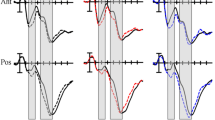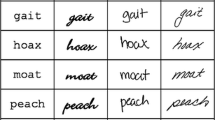Abstract
An experiment addressed whether lexical decision response latency and error rate are influenced by orthographic neighborhood structure. It was found that words with several higher-frequency neighbors were responded to more slowly and less accurately than words with fewer higher-frequency neighbors, even though the stimulus words were matched oh number of neighbors, word frequency, neighborhood frequency, number of higher-frequency neighbors, word length, and number of syllables. The results indicate that frequency is a relative effect dependent on the structure of the neighborhood. A word at the “bottom” of its neighborhood will be affected by the lexical representations of its higher-frequency neighbors. However, a word at the “top” of its neighborhood does not appear to be affected by the lexical representations of its neighbors.
Similar content being viewed by others
References
Andrews, S. (1989). Frequency and neighborhood effects on lexical access: Activation or Search?Journal of Experimental Psychology: Learning, Memory, and Cognition, 15, 802–814.
Andrews, S. (1992). Frequency and neighborhood effects on lexical access: Lexical similarity or orthographic redundancy?Journal of Experimental Psychology: Learning, Memory, and Cognition, 18, 234–254.
Becker, C. A. (1976). Allocation of attention during visual word recognition.Journal of Experimental Psychology: Human Perception and Performance, 2, 556–566.
Becker, C. A. (1980). Semantic context effects in visual word recognition.Journal of Experimental Psychology: Human Perception and Performance, 2, 556–566.
Coltheart, M., Davelaar, E., Jonasson, J. T., & Besner, D. (1977). Access to the internal lexicon. In S. Dornic (Ed.),Attention and performance VI. Hillsdale, NJ: Erlbaum.
Forster, K. I. (1976). Accessing the mental lexicon. In R. J. Wales & E. Walker (Eds.),New approaches to language mechanisms (pp. 257–287). Amsterdam: North-Holland.
Forster, K. I. (1989). Basic issues in lexical processing. In W. Marslen-Wilson (Ed.),Lexical representation and process (pp. 75–107). Cambridge, MA: MIT Press.
Goldinger, S. D., Luce, P. A., & Pisoni, D. B. (1989). Priming lexical neighbors of spoken words: Effects of competition and inhibition.Journal of Memory and Language, 38, 501–518.
Grainger, J. (1990). Word frequency and neighborhood frequency effects in lexical decision and naming.Journal of Memory and Language, 29, 228–244.
Grainger, J., O'Regan, J. K., Jacobs, A. M., & Segui, J. (1989). On the role of competing word units in visual word recognition: The neighborhood frequency effect.Perception and Psychophysics, 45, 189–195.
Grainger, J., & Segui, J. (1990). Neighborhood frequency effects in visual word recognition: A comparison of lexical decision and masked identification latencies.Perception and Psychophysics, 47, 191–198.
Grainger, J., O'Regan, J. K., Jacobs, A. M., & Segui, J. (1992). Neighborhood frequency effects and letter visibility in visual word recognition.Perception and Psychophysics, 51, 49–56.
Kucera, F., & Francis, W. (1967).Computational analysis of present-day American English. Providence, RI: Brown University Press.
Laxon, V. J., Coltheart, V., & Keating, C. (1988). Children find friendly words friendly too: Words with many orthographic neighbors are easier to read and spell.British Journal of Educational Psychology, 58, 103–119.
Luce, P. A. (1986). Neighborhoods of words in the mental lexicon.Research on speech perception (Tech. Rep. No. 6). Bloomington, IN: Indiana University.
Luce, P. A., Pisoni, D. B., & Goldinger, S. D. (1990). Similarity neighborhoods of spoken words. In G. Altmann (Ed.),Cognitive models of speech processing: Psycholin-guistic and computational perspectives (pp. 122–147). Cambridge, MA: MIT Press.
McClelland, J. L., & Rumelhart, D. E. (1981). An interactive activation model of context effects in letter perception.Psychological Review, 88, 315–407.
Paap, K. R., Newsome, S. L., McDonald, J. E., & Schvaneveldt, R. W. (1982). An activation-verification model for letter and word recognition: The word superiority effect.Psychological Review, 89, 573–594.
Paap, K. R., McDonald, J. E., Schvaneveldt, R. W., & Noel, R. W. (1987). Frequency and pronounceability in visually presented naming and lexical decision tasks. In M. Coltheart (Ed.),Attention and performance XII. Hove, E. Sussex: Lawrence Erlbaum Associates.
Rubenstein, H., Garfield, L., & Millikan, J. A. (1970). Homographic entries in the internal lexicon.Journal of Verbal Learning and Verbal Behavior, 9, 487–494.
Rumelhart, D. E., & McClelland, J. L. (1982). An interactive activation model of context effects in letter perception: Pt. 2. The contextual enhancement effect and some tests and extensions of the model.Psychological Review, 89, 60–94.
Seidenberg, M. S., & McClelland, J. L. (1989). A distributed developmental model of word recognition and naming.Psychological Review, 96, 523–568.
Snodgrass, J. G., & Mintzer, M. (1993). Neighborhood effects in visual word recognition: Facilitatory or inhibitory?Memory and Cognition, 21, 247–266.
Author information
Authors and Affiliations
Additional information
Preparation of this report was supported by a University Foundation Research Grant and an Affirmative Action Faculty Development Award from San Jose State University, to Laree Huntsman. The authors thank Brian Cronk, Katherine Lemkuil, Joseph Tajnai, Ruzica Udovicic, and Michael Weinborn for their assistance with stimuli development, Nadirah Ihsan and Jeffrey Limon for their assistance with data collection, and especially Guy Woffmdin for his invaluable programming assistance.
Rights and permissions
About this article
Cite this article
Huntsman, L.A., Lima, S.D. Orthographic neighborhood structure and lexical access. J Psycholinguist Res 25, 417–429 (1996). https://doi.org/10.1007/BF01727000
Issue Date:
DOI: https://doi.org/10.1007/BF01727000




